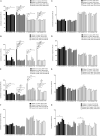Conservation Agriculture Affects Grain and Nutrient Yields of Maize (Zea Mays L.) and Can Impact Food and Nutrition Security in Sub-Saharan Africa
- PMID: 35155522
- PMCID: PMC8826957
- DOI: 10.3389/fnut.2021.804663
Conservation Agriculture Affects Grain and Nutrient Yields of Maize (Zea Mays L.) and Can Impact Food and Nutrition Security in Sub-Saharan Africa
Abstract
Maize is a major staple and plays an essential role in food and nutrition security in Sub-Saharan Africa (SSA). Conservation agriculture (CA), a climate-smart agriculture practise based on minimum soil disturbance, crop residue retention, and crop diversification, has been widely advocated but without extensive research on the impact it may have on maize nutrient composition, and food and nutrition security. This study assessed the grain yield, macro- and micronutrient mineral content, and nutrient yield of eight maize varieties grown in Malawi, and how these are affected by CA practises over two seasons. The minerals were analysed by inductively coupled plasma (ICP) coupled to optical emission spectroscopy (OES) and to mass spectroscopy (MS). Grain yield and Se content differed among the varieties, while C, N, Fe, K, Mg, Mn, P, and Zn were similar. The local variety Kanjerenjere showed lowest grain and nutrient yields. The open-pollinated varieties (OPVs) concentrated more minerals than the F1 hybrids, but the latter showed higher yields for both grain and nutrients. Typical consumption of the eight maize varieties could fully meet the protein and Mg dietary reference intake (DRIs) of Malawian children (1-3 years), as well as Mg and Mn needs of adult women (19-50 years), but their contribution to dietary requirements was low for Fe (39-41%) and K (13-21%). The trials showed that CA increased grain yield (1.2- to 1.8-fold) and Se content (1.1- to 1.7-fold), but that it had no effect on C, K, Mg, P, and Zn, and that N (1.1- to 1.2-fold), Mn (1.1- to 1.8-fold), and Fe (1.3- to 3.4-fold) were reduced. The high increase in grain yield under CA treatments resulted in increased yields of protein and Se, no effect on the yields of K, Mg, Mn, P, Zn, and reduced Fe yield. Conservation agriculture could contribute in reducing the risk of Se deficiency in Malawian women and children but exacerbates the risk of Fe deficiency. A combination of strategies will be needed to mitigate some of the foreseen effects of climate change on agriculture, and food and nutrition security, and improve nutrient intake.
Keywords: Malawi; climate change; maize varieties; micronutrient deficiencies; nutrition security.
Copyright © 2022 Galani, Ligowe, Kieffer, Kamalongo, Kambwiri, Kuwali, Thierfelder, Dougill, Gong and Orfila.
Conflict of interest statement
The authors declare that the research was conducted in the absence of any commercial or financial relationships that could be construed as a potential conflict of interest.
Figures









References
-
- FAO . Food and Agriculture Organization of the United Nations. FAOSTAT Database. Rome: FAO; (2021). Available online at: http://www.fao.org/faostat/en/#home (accessed February 15, 2021).
-
- VIB. Maize in Africa . VIB International Plant Biotechnology Outreach. Fact Series. Ghent: VIB; (2017). Available online at: http://www.vib.be/en/about-vib/Documents/VIB_MaizeInAfrica_EN_2017.pdf (accessed September 17, 2020).
-
- Mathenge MK, Smale M, Olwande J. The impacts of hybrid maize seed on the welfare of farming households in Kenya. Food Policy. (2014) 44:262–71. 10.1016/j.foodpol.2013.09.013 - DOI
LinkOut - more resources
Full Text Sources
Research Materials

